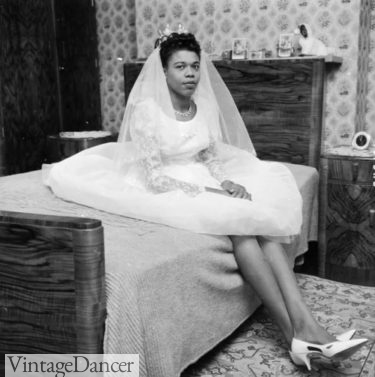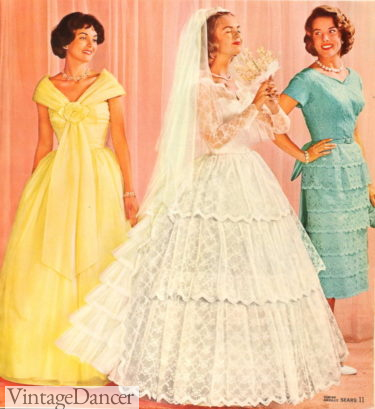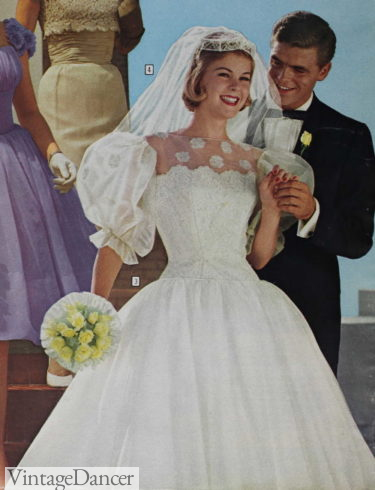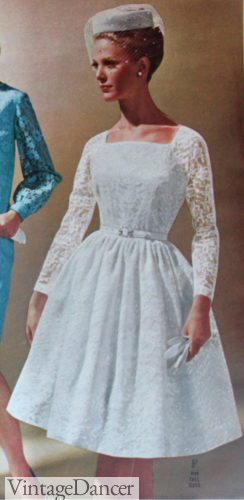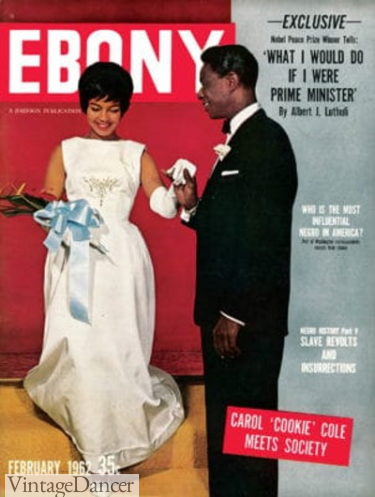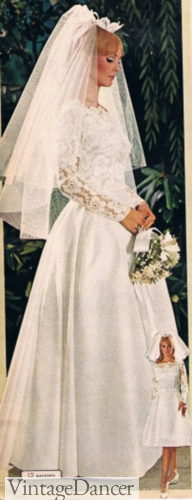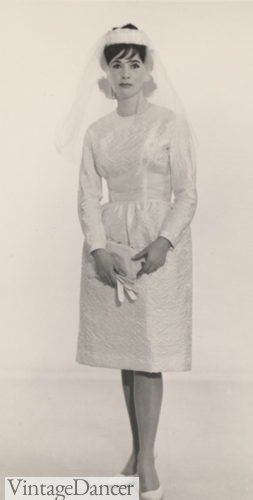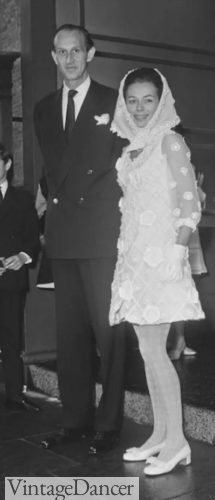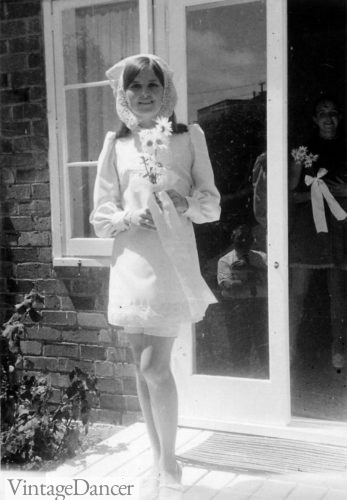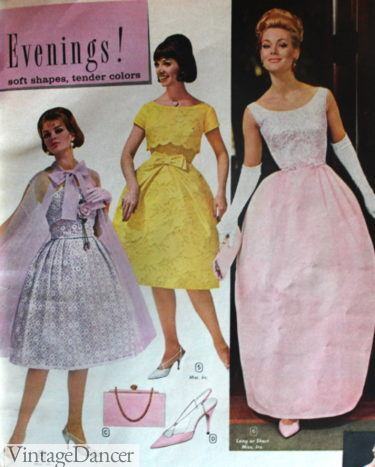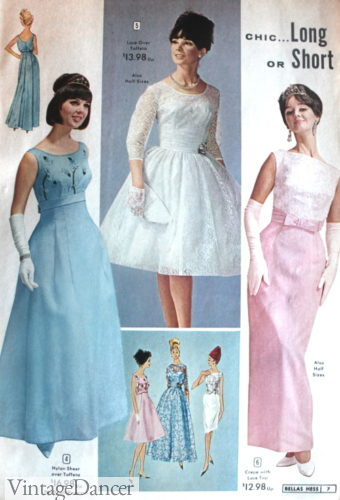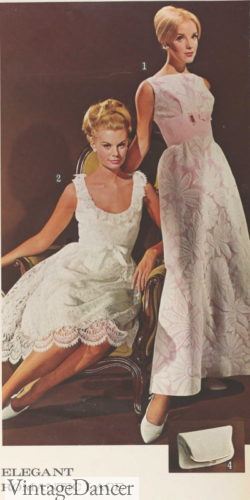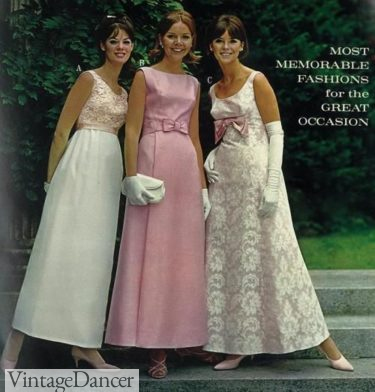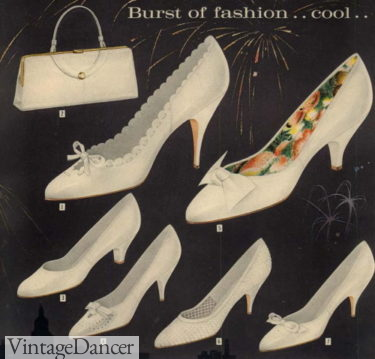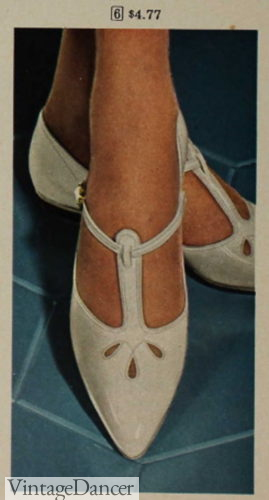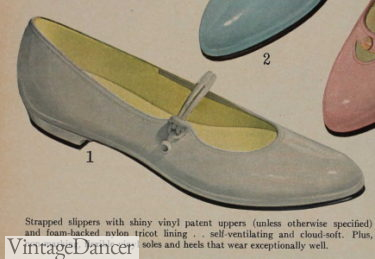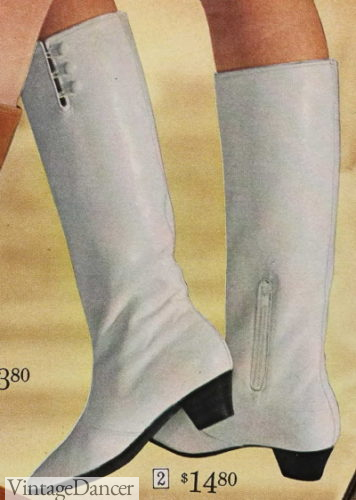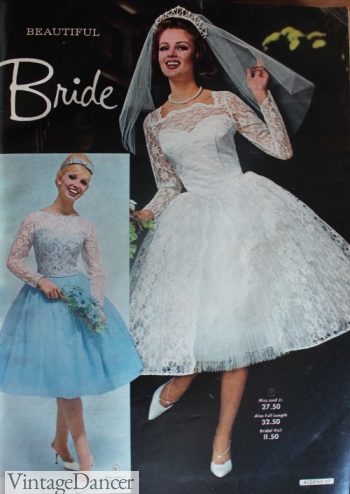
1964 lace knee length swing wedding dress and blue bridesmaid dress
The 1960s wedding: ten years of growing pains. The world was deciding, a little more each day, exactly what it wanted to be, and it showed from head to toe. Fashions changed more from 1960 to 1969 than perhaps during any other period in history, and wedding photos make a fascinating window.
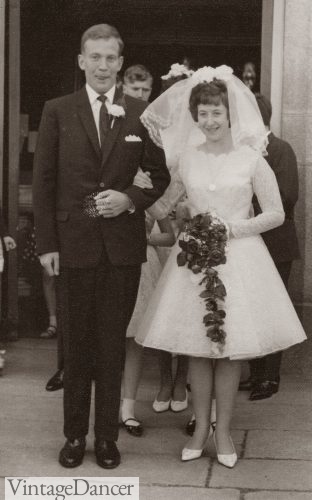
Early 1960s swing wedding dress
It might seem that the traditional white wedding has stayed the same forever, but look closer: the dress and its accessories changed subtly with the times. 1960s wedding dresses, bridesmaid dresses, and mother of the bride dresses reflects the era’s uncertainty and exhilaration — not to mention some truly fabulous hair.
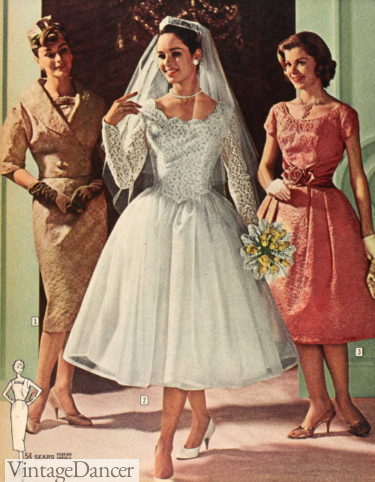
1960 lace and tulle wedding dress
The 1960s Bride
The early ‘60s wedding gown retained the swing dress volume of the ‘50s, but the seams began to streamline and the hems began to rise. Brides of the 1950s celebrated the end of wartime austerity by going big or going home.
“The 50s herald a return to formality after the roaring twenties, The Great Depression and wartime weddings,” explains Babble’s Monica Bielanko. “Fancy church services are all the rage. Think Wedgewood china, white roses, cut glass, and silver on damask cloths.”
- 1960 knee length wedding dress
- 1960 lace tiered wedding dress
- 1961 brief fad for gigot sleeve gowns
- 1965 knee length lace wedding dress
To top it off, a dress of royal proportions: think Cinderella at the ball. Dior’s New Look silhouette was still popular in the early 1960s, but elements of a new decade were emerging. Brides paired their princess wedding dresses with bouffants and veiled pillbox hats. The long dress trend was equally popular as hemlines grew shorter and shorter on “modern wedding dresses.” Trains diminished in size, vanishing to nothing as the minidress hit the scene.
- 1962 satin wedding dress
- Classic Lace Wedding Dress
- 1964 tulle wedding dress
- 1965 bow belt wedding dress
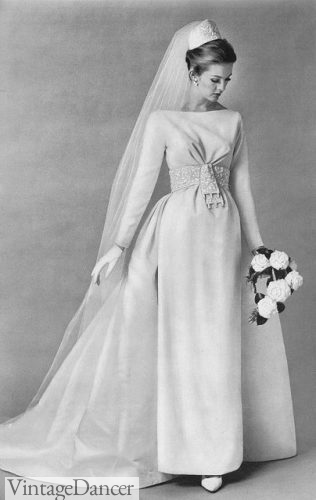
Mid 1960s column wedding dress with long veil and pill box hat
Over the next few years, wedding dress skirts narrowed and waistlines rose. The mod silhouette of swinging London had made it to the church aisle. Wedding dresses were simpler in shape than the previous decade’s confections. Most common was an A-line silhouette with an empire waist — a longer-sleeved, more columnar version was popular as well.
- Mid 1960s column wedding dress with long veil and pill box hat
- 1960 Elsa Millenson wedding
Most brides still maintained tradition by wearing white, though a daring few said “I do” in fashionable florals or pastels. Veils were still common, though taller and more voluminous than their ‘50s counterparts, echoing the teased hair that came to define the decade. If a bride’s hair was high enough, she might forego the ’60s wedding veil and let it speak for itself!
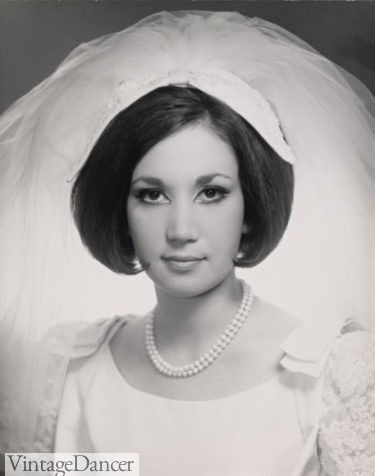
1960 Barbara Morris
Other brides chose elaborate wedding headbands, dressed-up versions of the ones that were popular for daywear. Metallic embellishments were common — it was the Space Age, after all. A more bohemian bride might forego both headband and veil and opt for a floppy hat!
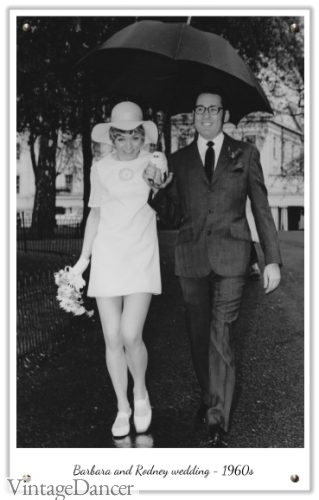
Late 1960s short midi wedding dress and floppy hat
Brides everywhere, though, were united by a love of daisies. The cheerful bloom was emblematic of the ‘60s, and it popped up everywhere from ’60s bridal bouquets to lacy overlays. Jewelry, seen as frumpy and unbearably passe, was on the decline; wispy florals advertised youth.
- Daisy flower mini dress with scarf
- Daisy scarf and short wedding dress
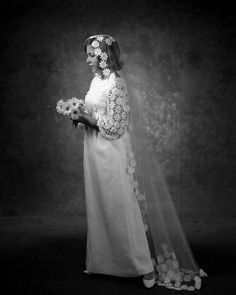
Daisy wedding dress sleeves, veil and bouquet
Even paper dresses, that most baffling ‘60s trend, made it to the altar. Scott Paper Company’s “Paper Capers” (actually a paper-rayon blend) were all the rage in ‘66 and ‘67. The pop-art pinups are perhaps best associated with Campbell’s “Souper” edition, but, as Stephanie Buck reports, they came in bridal white for $15 each.
The craze died down within a year, but the implication was clear: youth culture had infiltrated weddings, and it wasn’t going anywhere. Gone were the somber affairs of a century past — the modern bride was doing her thing, on her terms, in her dress. “The generation gap,” wrote Marnie Fogg in Vintage Weddings: One Hundred Years of Bridal Fashion and Style, “was never more evident than when choosing a wedding dress.” She quotes Homes and Gardens columnist Verity Lambert, who wrote in 1966:
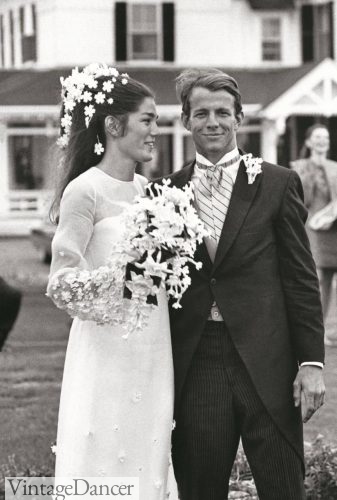
Daisies in the hair and bouquet
“I set off round the shops in advance to see what this season’s bride will be wearing. What an eye-opener it is to the uninitiated to find so much space set apart in so many of the big stores for brides! Row upon row of brocade, satin, net, lace and all kinds of white gowns with and without trains waiting to be chosen. … After several visits I am still trying to persuade her to try on just one of those wedding dresses. “It would take ten years off my life,” she whispers, appalled by what she sees. After many visits she settles for six yards of silk tulle, and only enough white cotton curtain lace to make a skin-tight dolly-rocker, “for some little woman to make up something really with it.” But what little woman will make anything up that has been left so late? Only one, and down she goes on her hands and knees on the drawing-room floor to cut out her daughter’s with-it white curtain lace dolly-rocker.”
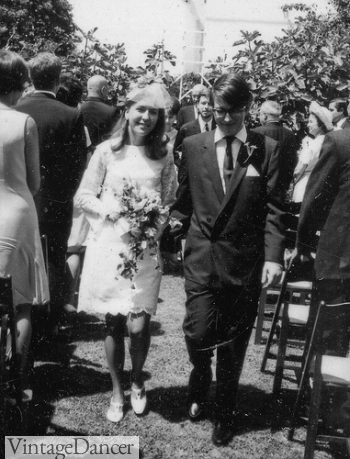
Penny and Kent, August 19, 1967
Even the more traditional brides were subject to the whims of ‘60s fashion. Princess Margaret’s 1960 wedding gown, though designed by court couturier Norman Hartnell and boasting several yards of skirt, was simpler and more streamlined than her sister’s had been. Six years later, Princess Beatrix of the Netherlands wed in a fashionable columnar gown.
Shop 60’s style wedding dresses
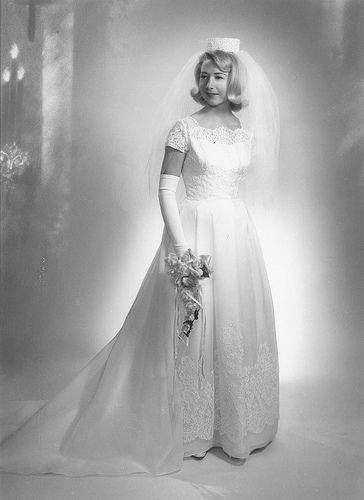
1966 wedding dress
1960s Bridesmaids
A few decades earlier, bridesmaids took pains to match the bride in every way possible — even by wearing white. By the 1960s, their outfits were firmly differentiated from the bride’s in color and often in shape.
For the ‘60s bridesmaid, pastels and candy tones were the order of the day. Hot pink and blue were perennially popular, laying ground for the pink taffeta explosion of the 1980s. Paired with matching pillbox hats, a row of blue dresses radiated stewardess vibes.
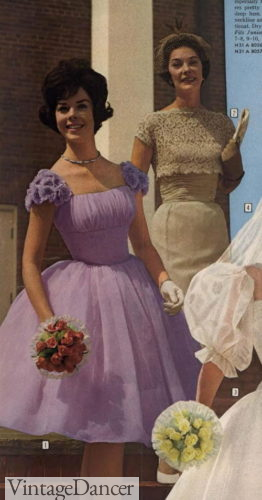
1961 lilac bridesmaid dress
Slimmer, more columnar dresses ruled the decade’s later half. Short puffed sleeves were a ‘30s throwback, longer ones more Grecian. These gowns often came in shades of blue and green, foreshadowing the 1970s’ shift toward ocean and forest themes.
- 1964 evening dresses
- 1964 formal gowns
- 1965 wedding dresses, bridesmaid
- 1966 prom dresses
Colorblocked versions were also popular, usually featuring a bodice of one color and an empire-waist skirt of another. Some of these took a cue from the Victorian tradition and included a white skirt to match the bride. Others, bucking the matchy-matchy trend, came in a range of pastels.
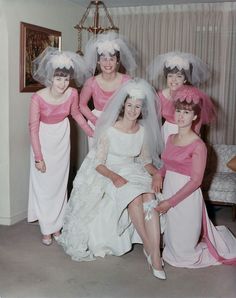
1960s Pink tops and white skirt bridesmaid dresses
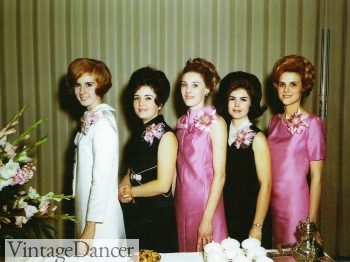
Black and pink bridesmaid dresses (my favorite!)
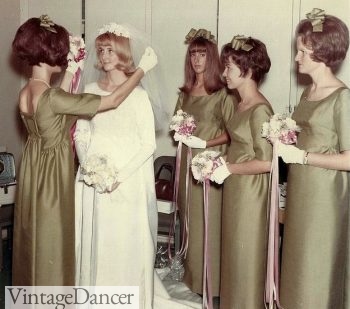
Late 1960s olive green bridesmaid dresses with matching headbands
Shop 1960s bridesmaid and party dresses.
1960s Mother of the Bride
Brides’ mothers wore the same pastels and candy shades as the rest of the party. Unsurprisingly, though, they avoided the youthful silhouettes of their daughters’ generation. Staying current was a must, but women of a certain age preferred Jackie to Twiggy.
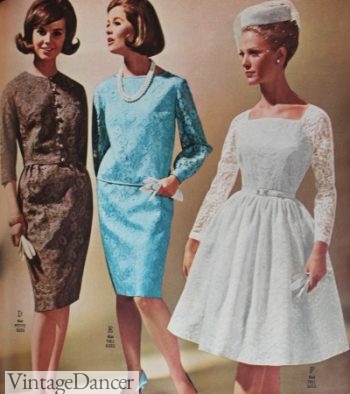
1964 mothers sheath dresses
While her daughter strolled the aisle in A-lines and empire waists, Mother donned a tastefully textured dress suit. Older women who preferred something less current, or who simply couldn’t afford a wardrobe update, might have worn floral shirtwaists a la Betty Draper.
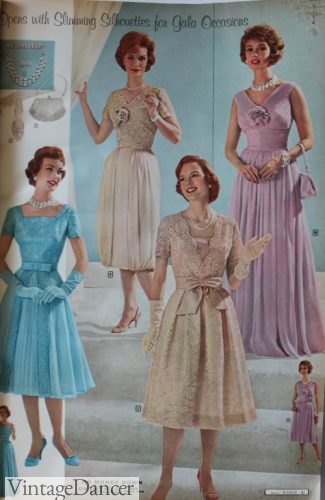
1960 lace mother’s dresses
Hats were something mothers and daughters could agree on! Both the pillbox and its broad-brimmed cousin were popular with women of all ages.
Learn more about party and evening dresses that were selected for bridesmaids and mother’s gowns.
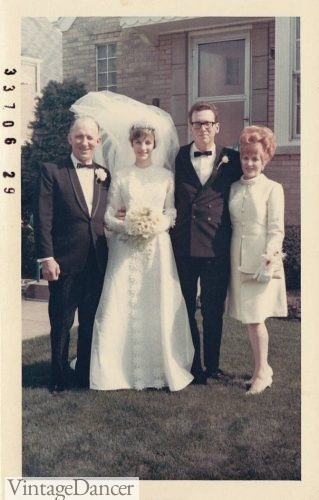
Mid 1960s wedding bride (daisy dress!), groom, mother and father. Mother wears ivory.
Shop 1960s bridesmaid and mother’s dresses.
1960s Bridal Shoes
Brides of the early ’60s still embraced the stalwart footwear of the ’50s and earlier. Pilgrim buckles, first made trendy a decade earlier, remained in fashion; stilettos and kitten heels were classics.
Mary Janes, though, were the truly “switched-on” option. These strappy flats, once the province of preteens, were all the rage with youthquake brides. Vogue declared in May 1963 that the new wedding looks were “younger than ever” — Mary Janes were a natural fit. Learn more about 1960s shoe styles.
Lower heels also dovetailed nicely with another late-’60s trend: patterned stockings. Flat white shoes and a lacy leg were must-haves for the cutting-edge bohemian bride.
Shop vintage style wedding shoes.
- 1961 heels
- 1965 T Strap heels
- 1965 mary jane vinyl shoes
- 1967 go go boots
See 58 pictures of real 1960s wedding couples.
Debbie Sessions has been teaching fashion history and helping people dress for vintage themed events since 2009. She has turned a hobby into VintageDancer.com with hundreds of well researched articles and hand picked links to vintage inspired clothing online. She aims to make dressing accurately (or not) an affordable option for all. Oh, and she dances too.
